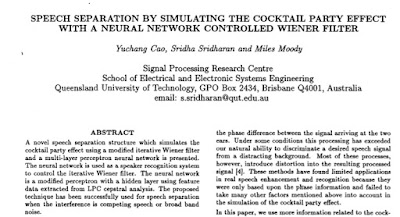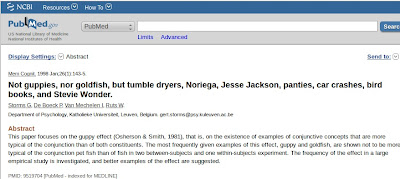Articoli scientifici con titoli o autori bizzarri (Scientific articles with authors or bizarre titles)
Diffusion in a Periodic Lorentz Gas
Journal of Statistical Physics, Vol. 48, Nos. 3/4, 1987. Bill Moran (Lawrence Livermore National Laboratory, and Department of Applied Science, University
of California at Davis-Livermore, Livermore, California) William G. Hoover (Lawrence Livermore National Laboratory, and Department of Applied Science, University of California at Davis-Livermore, Livermore, California) and Stronzo Bestiale (Institute for Advanced Studies at Palermo)
["Stronzo Bestiale" (which roughly translates into English as "Nasty piece of Sheet")]
 Missing entry replacement data analysis: a replacement approach to dealing with missing data in Paleontological and total evidence data sets. by Mark A Norell, Ward C Wheeler
Missing entry replacement data analysis: a replacement approach to dealing with missing data in Paleontological and total evidence data sets. by Mark A Norell, Ward C Wheeler
Journal of Vertebrate Paleontology (2003). Volume: 23, Issue: 2, Publisher: The Society of Vertebrate Paleontology, Pages: 275-283
Abstract
Almost all phylogenetic studies utilizing fossils are faced with the problem of missing data. With the development of methods allowing total evidence phylogenies where fossils are combined with extant taxa, and molecular evidence is available, this problem is compounded. Standard methods ignore missing data and often result in poorly resolved trees, and procedures such as culling of taxa or partitioning data have been proposed to improve resolution. Here, we take a different tack, one grounded in the fact that because we do not know what the behavior of missing data would be, it is worthwhile to examine the universe of possible outcomes. The MERDA value is the frequency with which a particular clade is recovered in replicated analyses where missing observations are replaced randomly with observable states. A technique to de-resolve missing data-dependent clades is also proposed. We also show that, in published data sets, there is little obvious relationship between MERDA performance and standard measures of clade support such as Bremer and Jacknife indices.
 Speech separation by simulating the cocktail party effect with a neural network controlled Wiener filter. Yuchang Cao, Sridharan, S., Moody, M. (School of Electr. & Electron. Syst. Eng., Queensland Univ. of Technol., Brisbane). In the Proceedings of the 1997 IEEE International Conference on Acoustics, Speech, and Signal Processing (ICASSP '97). Volume 4.
Speech separation by simulating the cocktail party effect with a neural network controlled Wiener filter. Yuchang Cao, Sridharan, S., Moody, M. (School of Electr. & Electron. Syst. Eng., Queensland Univ. of Technol., Brisbane). In the Proceedings of the 1997 IEEE International Conference on Acoustics, Speech, and Signal Processing (ICASSP '97). Volume 4.
Abstract
A novel speech separation structure which simulates the cocktail party effect using a modified iterative Wiener filter and a multi-layer perceptron neural network is presented. The neural network is used as a speaker recognition system to control the iterative Wiener filter. The neural network is a modified perceptron with a hidden layer using feature data extracted from LPC cepstral analysis. The proposed technique has been successfully used for speech separation when the interference is competing speech or broad band noise.
 Not guppies, nor goldfish, but tumble dryers, Noriega, Jesse Jackson, panties, car crashes, bird books, and Stevie Wonder. Storms G, De Boeck P, Van Mechelen I, Ruts W. (Department of Psychology, Katholieke Universiteit, Leuven, Belgium)
Not guppies, nor goldfish, but tumble dryers, Noriega, Jesse Jackson, panties, car crashes, bird books, and Stevie Wonder. Storms G, De Boeck P, Van Mechelen I, Ruts W. (Department of Psychology, Katholieke Universiteit, Leuven, Belgium)
Abstract
This paper focuses on the guppy effect (Osherson & Smith, 1981), that is, on the existence of examples of conjunctive concepts that are more typical of the conjunction than of both constituents. The most frequently given examples of this effect, guppy and goldfish, are shown not to be more typical of the conjunction pet fish than of fish in two between-subjects and one within-subjects experiment. The frequency of the effect in a large empirical study is investigated, and better examples of the effect are suggested.
Altri titoli bizzarri, una lunga lista: Here's a random list of papers in Theoretical Computer Science with cute titles.
Ma a mio parere il capolavoro assoluto resta sempre Chicken chicken chicken:
Doug Zongker's "Chicken chicken chicken". Presented at the AAAS humor session, February 16, 2007.

Journal of Statistical Physics, Vol. 48, Nos. 3/4, 1987. Bill Moran (Lawrence Livermore National Laboratory, and Department of Applied Science, University
of California at Davis-Livermore, Livermore, California) William G. Hoover (Lawrence Livermore National Laboratory, and Department of Applied Science, University of California at Davis-Livermore, Livermore, California) and Stronzo Bestiale (Institute for Advanced Studies at Palermo)
["Stronzo Bestiale" (which roughly translates into English as "Nasty piece of Sheet")]
 Missing entry replacement data analysis: a replacement approach to dealing with missing data in Paleontological and total evidence data sets. by Mark A Norell, Ward C Wheeler
Missing entry replacement data analysis: a replacement approach to dealing with missing data in Paleontological and total evidence data sets. by Mark A Norell, Ward C WheelerJournal of Vertebrate Paleontology (2003). Volume: 23, Issue: 2, Publisher: The Society of Vertebrate Paleontology, Pages: 275-283
Abstract
Almost all phylogenetic studies utilizing fossils are faced with the problem of missing data. With the development of methods allowing total evidence phylogenies where fossils are combined with extant taxa, and molecular evidence is available, this problem is compounded. Standard methods ignore missing data and often result in poorly resolved trees, and procedures such as culling of taxa or partitioning data have been proposed to improve resolution. Here, we take a different tack, one grounded in the fact that because we do not know what the behavior of missing data would be, it is worthwhile to examine the universe of possible outcomes. The MERDA value is the frequency with which a particular clade is recovered in replicated analyses where missing observations are replaced randomly with observable states. A technique to de-resolve missing data-dependent clades is also proposed. We also show that, in published data sets, there is little obvious relationship between MERDA performance and standard measures of clade support such as Bremer and Jacknife indices.
 Speech separation by simulating the cocktail party effect with a neural network controlled Wiener filter. Yuchang Cao, Sridharan, S., Moody, M. (School of Electr. & Electron. Syst. Eng., Queensland Univ. of Technol., Brisbane). In the Proceedings of the 1997 IEEE International Conference on Acoustics, Speech, and Signal Processing (ICASSP '97). Volume 4.
Speech separation by simulating the cocktail party effect with a neural network controlled Wiener filter. Yuchang Cao, Sridharan, S., Moody, M. (School of Electr. & Electron. Syst. Eng., Queensland Univ. of Technol., Brisbane). In the Proceedings of the 1997 IEEE International Conference on Acoustics, Speech, and Signal Processing (ICASSP '97). Volume 4.Abstract
A novel speech separation structure which simulates the cocktail party effect using a modified iterative Wiener filter and a multi-layer perceptron neural network is presented. The neural network is used as a speaker recognition system to control the iterative Wiener filter. The neural network is a modified perceptron with a hidden layer using feature data extracted from LPC cepstral analysis. The proposed technique has been successfully used for speech separation when the interference is competing speech or broad band noise.
 Not guppies, nor goldfish, but tumble dryers, Noriega, Jesse Jackson, panties, car crashes, bird books, and Stevie Wonder. Storms G, De Boeck P, Van Mechelen I, Ruts W. (Department of Psychology, Katholieke Universiteit, Leuven, Belgium)
Not guppies, nor goldfish, but tumble dryers, Noriega, Jesse Jackson, panties, car crashes, bird books, and Stevie Wonder. Storms G, De Boeck P, Van Mechelen I, Ruts W. (Department of Psychology, Katholieke Universiteit, Leuven, Belgium)Abstract
This paper focuses on the guppy effect (Osherson & Smith, 1981), that is, on the existence of examples of conjunctive concepts that are more typical of the conjunction than of both constituents. The most frequently given examples of this effect, guppy and goldfish, are shown not to be more typical of the conjunction pet fish than of fish in two between-subjects and one within-subjects experiment. The frequency of the effect in a large empirical study is investigated, and better examples of the effect are suggested.
Altri titoli bizzarri, una lunga lista: Here's a random list of papers in Theoretical Computer Science with cute titles.
Ma a mio parere il capolavoro assoluto resta sempre Chicken chicken chicken:
Doug Zongker's "Chicken chicken chicken". Presented at the AAAS humor session, February 16, 2007.





Commenti